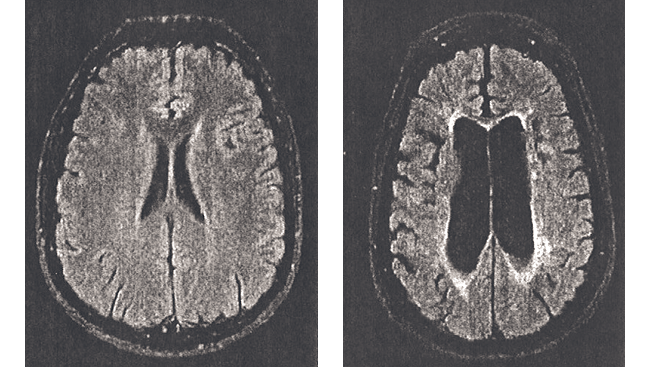Animal Research Success: Multiple Sclerosis
- Published9 Mar 2012
- Reviewed9 Mar 2012
- Author Emily K. Dilger, PhD
- Source BrainFacts/SfN
Multiple Sclerosis (MS) is an autoimmune disease in which the body’s immune system attacks the fatty insulating material (myelin) that surrounds axons in the brain and spinal cord. When the myelin is lost (demyelination), axons cannot effectively conduct electrical signals, so nerve cells are unable to communicate with each other. Since myelin and electrical conduction in nerves also serve to protect nerve cells, nerve axons can die during demyelination.

Multiple sclerosis occurs when the body’s immune system mistakenly destroys the myelin sheath covering neurons. Such damage can be seen in brain scans, which are increasingly being used to help diagnose the disease and track its progress. Significant tissue loss (represented by dark areas) is apparent in the brain of a 43-year-old woman (B) who has had multiple sclerosis for 19 years, compared to the brain of a healthy 31-year-old man (A).
Symptoms of MS can include visual disturbance, weakness, and poor coordination, depending on the brain regions affected. In addition, many patients with MS develop progressive paralysis due to axon degeneration. Lost myelin can be replaced naturally (remyelination), but this process is usually incomplete, leaving the axon exposed and vulnerable. Experiments using animals have helped researchers better understand how the disease progresses. This understanding has led to the development of a number of therapies to slow the course of the disease.
The demyelination of MS can be replicated in animals by injecting them with components of myelin. These materials generate an immune response that causes brain inflammation and attacks the animal’s myelin. This model, called experimental allergic encephalitis (EAE), can be generated in a variety of animal species and has enabled scientists to understand how myelin is damaged throughout the course of MS. The model has also been valuable in the development of medications, which are currently undergoing clinical trials. These therapeutics modulate or suppress the immune system in patients with MS in an attempt to limit their symptoms.
Effective treatment of MS will also require drugs that repair myelin damage, or promote remyelination. The EAE model is less useful for testing these therapies, as it is difficult to tell if beneficial effects seen from a treatment are due to a reduction of the harmful immune response or myelin repair. Scientists have therefore developed other animal models in which myelin damage is caused by toxins. After the myelin is damaged, the animal’s normal myelin repair process begins. Then the effect of drugs designed to accelerate the process can be examined.
The use of various animal models will lead to an increasing number of effective drugs that either limit inflammation or promote repair in MS. Together, these drugs offer hope for real cures of the disease.
CONTENT PROVIDED BY
BrainFacts/SfN
Also In Archives
Trending
Popular articles on BrainFacts.org


















